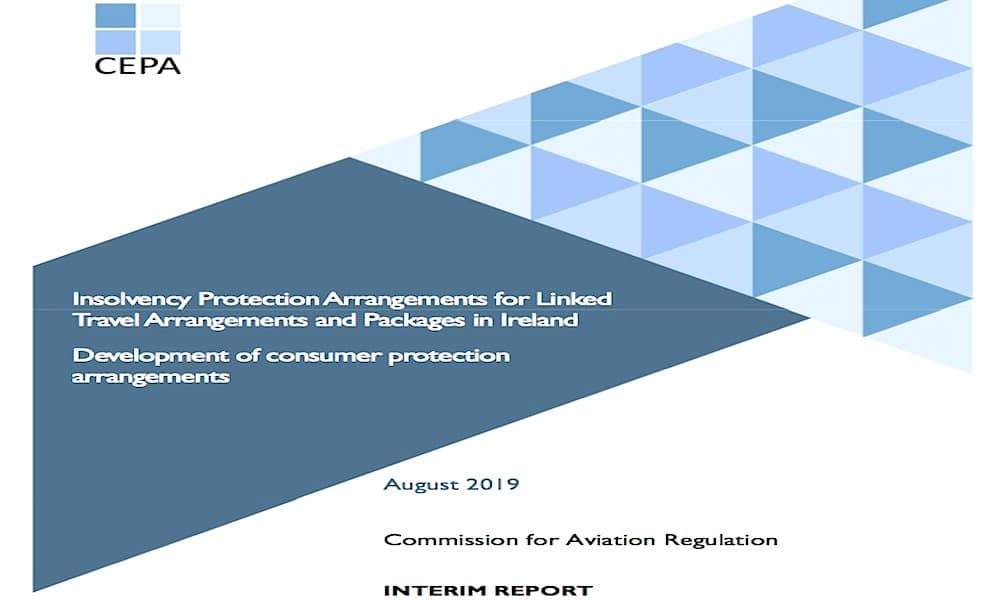
The Commission for Aviation Regulation (CAR) has published the Interim Report prepared by Cambridge Economic Policy Associates Ltd on Insolvency Protection Arrangements for Linked Travel Arrangements and Packages in Ireland, which concludes that: “Based on our assessment of the evidence, there is no clear preferred option, and there are trade-offs with any option. However on balance and provided that the cost of the necessary insurance is available at a reasonable price, Option F – which involves bonding to eligible turnover and buying excess insurance in the short term – provides the most benefits with the least disruption and cost to the industry compared to the other options.” Option F would require bonding of 8% for travel agents and LTAs and 20% for tour operators.
The report also concludes that: “All of the options inevitably increase the cost of providing protection for customers of package holidays. This reflects the current lack of an adequately funded TPF to pay out claims in excess of bonds. As our options are limited in scope to security for packages and LTAs under the relevant EU and Irish legislation, this may lead to some customers switching from purchasing package holidays to purchasing different components of their holidays separately.”
CEPA is advising the Commission on selecting a preferred option for reforming the current insolvency protection regime to comply with the EU Package Travel Directive 2015/2302 (EU PTD II). This work follows the 2017 Stage I consultation where a shortlist of options was selected for further consideration. In selecting a preferred option, CEPA was asked to consider the bonding arrangements and how the Travellers’ Protection Fund can be replenished, building on three reform options proposed in Stage 1. It was also given the latitude to propose new options not considered in Stage I, and options that require legislative change.
CEPA’s Interim Report considers seven options, including Options C, D and E from Stage 1:
Option C: Increase the TPF through a levy on travel organisers and leave bonds unchanged
Option D: Bond to eligible turnover
Option E: Bond to eligible turnover and prevent firms trading above projected licensable turnover
Option F: Bond to eligible turnover with excess insurance in the short term
Option G: Bond to turnover at risk with excess insurance in the short term
Option H: Firm level insurance
Option I: Pooled insolvency arrangements funded with excess insurance in the short term
The consultation paper is available here and the interim report is available here. At the end of the consultation period, CEPA will finalise its report and this will form the basis of advice to the Department of Transport, Tourism and Sport. The Commission invites the views of interested parties, by email, to [email protected] before 5pm, 18 September 2019.
Interim Report Conclusion
Based on our assessment of the evidence, there is no clear preferred option, and there are trade-offs with any option. However on balance and provided that the cost of the necessary insurance is available at a reasonable price, Option F – which involves bonding to eligible turnover and buying excess insurance in the short term – provides the most benefits with the least disruption and cost to the industry compared to the other options. In addition, firms who wish to operate outside of Option F could purchase insurance coverage – Option H: Firm level insurance.
Option F bases bonding on eligible turnover, defined as PLTO excluding:
payments made to suppliers immediately, where customer payments are less at risk in the event of a travel organiser insolvency as suppliers are still able to fulfil their portion of the holiday; and
payments made in arrears by customers, which would not be at risk in the event of an insolvency
It requires bonding of 8% for travel agents and LTAs and 20% for tour operators and allows CAR to increase bonding requirements for individual firms if they believe they are at higher risk of insolvency, or at risk of being insufficiently bonded. This may be the case if, for example, a firm is new and has adopted an untested business model or if CAR suspects that a firm’s PLTO is being understated.
This option imposes a levy of 0.10% of LTO initially, which results in a relatively slow replenishment of the TPF over 10 years. To achieve this without a long period of risk exposure, we propose using the remaining funds in the TPF to purchase insurance against claims exceeding a firm’s bond and potentially a portion of the proceeds from the new levy to purchase insurance in later years (if required) until the TPF is fully replenished. This would be a short-term measure to ensure that there is no gap in coverage while the TPF is replenished. The cost of insurance at this stage is unknown and therefore it is difficult to predict for how long the existing TPF funds would cover the insurance premium. (We have used a very conservative estimate of the cost of insurance to model this scenario. The information provided here is based on insurance costing no more than our estimate.) Ultimately this would require market testing to determine what insurers are likely to charge. Alternatives, once existing TPF funds are used up, would be for the Government to provide a short-term guarantee, or the levy could be temporarily increased to accelerate replenishment. This option is also subject to the appropriate product being made available for the short-term TPF cover through insurance providers at an acceptable cost.
The use of insurance in the shorter term avoids a large one-off cost for travel organisers, though it does mean a higher on-going levy. With an initial levy of 0.12% of LTO, enough funds should be raised in 10 years to replenish the TPF. After this period, insurance cover would no longer be needed and the on-going levy could be reduced to 0.06% of LTO.
Option F provides CAR with more discretion to scrutinise firms and their bonding levels, enabling them to react to and manage potential insolvency risks, thus increasing the effectiveness and resilience of the scheme without significantly increasing the overall cost of bonding to the industry. It may have a small negative impact on competitiveness and will introduce some additional administrative requirements, compared with the current regime.
Compared with Options C, D and E, firms would be subject to lower contributions to the TPF in the short term as claims that exceed bonding levels would initially be covered through insurance paid for from existing TPF funds. Although Option F may cost more for the industry as a whole in the long run, it provides full cover in the short term at minimal upfront cost to industry. However, it does inflict higher administrative costs on the industry and CAR relative to the existing scheme and introduce levels of subjectivity. In addition, the practicalities of CAR applying their discretion to the bonding levels would need to be worked through.
Based on stakeholder feedback we expect parts of the industry to be attracted to Option I (a scheme similar to ATOL) and we acknowledge that the analysis places this close in the round to Option F. However, Option I is likely to impose significant up-front set up costs on CAR and new reporting requirements on the travel industry, i.e. the current regulatory burden is unlikely to be reduced. Under Option I, CAR could be required to closely monitor a large number of firms in more detail at least initially whereas in Option F, most firms would be adequately covered by the bonding rules. On balance we consider that Option F is also likely to be more stable in the longer term relative to Option I, with less likelihood of CAR needing to increase the levy in future. There is some evidence to suggest that ATOL-like schemes may become more expensive as they evolve – the ATOL levy increased by 250% in the UK after four years and there is at least anecdotal evidence that this negatively impacted sales. However, an ATOL-like scheme has the advantage that it could probably more easily be expanded to cover a larger portion of the travel trade should Government policy towards insolvency protection change in future.
In any event reforming the scheme will take time due to required legislative changes, in addition to set-up costs and the run-down period on current bonding arrangements. The low level of the TPF creates concern, in the short term at least, that consumers may not be covered in the event of another large insolvency. In the interim, CAR has options available to mitigate this risk: obtain a Government guarantee that would come into effect if the TPF were fully depleted in the interim; pro-rate claims to the extent possible (noting that this is not what the European legislation requires); explore the purchase of insurance for excess cover; or charge a temporary levy to TOs that require legislative change. This avoids a gap in coverage and, as it will be required to obtain under the recommended Option F, also avoids additional administrative arrangements.
All of the options inevitably increase the cost of providing protection for customers of package holidays. This reflects the current lack of an adequately funded TPF to pay out claims in excess of bonds. As our options are limited in scope to security for packages and LTAs under the relevant EU and Irish legislation, this may lead to some customers switching from purchasing package holidays to purchasing different components of their holidays separately.




